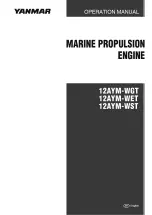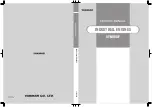
ENGINE
Inspecting the Cylinder Block and Components
5-54
6LY3 Service Manual
© 2007 Yanmar Marine International
Inspecting the Intake / Exhaust
System
Intake System Components
Air enters the intake silencer
(Figure 5-77, (4))
which is installed on the turbocharger
(Figure 5-77, (5))
. It travels through the
turbocharger and the intercooler
(Figure 5-77, (3))
and is fed to the intake manifold.
Figure 5-77
Figure 5-77
1 – Exhaust Manifold
2 – Cylinder Head
3 – Intercooler
4 – Intake Silencer
5 – Turbocharger
When the inside of the intake manifold becomes
dirty, air resistance increases and reduces engine
power. Check the inside of the intake manifold and
the inlet of the air silencer at their scheduled
inspection interval. Clean and clear, as necessary.
Clean the mating surfaces of the intake manifold
and cylinder head when assembling. Ensure there
is no air leak.
NEVER operate an engine with the intake air
silencer removed.
Exhaust System Components
Exhaust gas
(Figure 5-78, (4) and (5))
enters the
turbocharger
(Figure 5-78, (6))
through the
exhaust manifold
(Figure 5-77, (1))
(in the coolant
tank) which is installed on the cylinder head
(Figure 5-77, (2))
. The exhaust gas flows to the
mixing elbow
(Figure 5-78, (2))
, through the
turbocharger, and is discharged from the vessel
along with seawater.
Figure 5-78
Figure 5-78
1 – Exhaust Bend
2 – Mixing Elbow
3 – Seawater Pipe
4 – Exhaust Gas
5 – Exhaust Gas
6 – Turbocharger
Inspecting the Mixing Elbow
The mixing elbow is attached to the exhaust outlet
of the turbocharger. After extended use, check and
clean the mixing elbow as outlined below:
1. Clean any dirt and scale out of the gas and
seawater lines.
2. Repair cracks or other damage to welded parts.
Replace parts if needed.
3. Inspect all gaskets and replace as necessary.
Air
Exhaust gas
0006
3
14
(4)
(5)
(1)
(2)
(
3
)
0006
3
15
(6)
(5)
(4)
(1)
(2)
(
3
)
















































